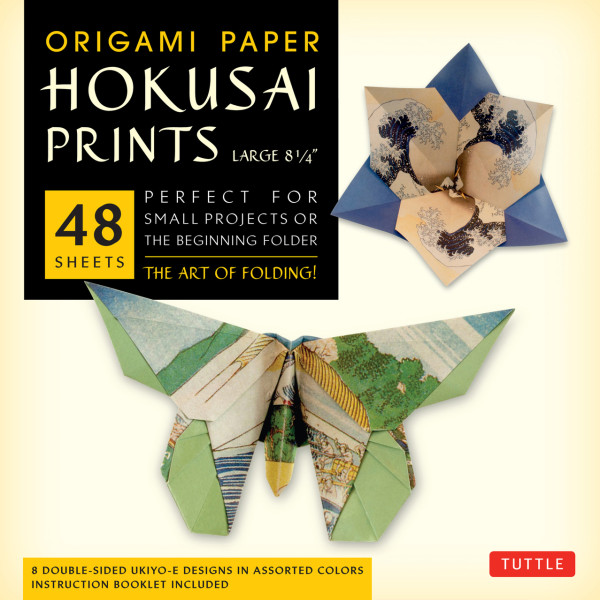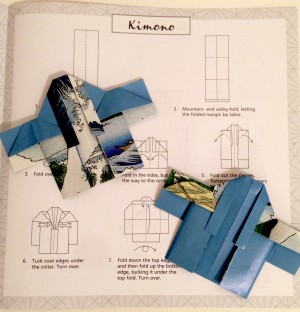 Maybe this is a stretch for being a “book,” but to learn origami (at least when I was growing up before YouTube and internet tutorials), you used a book or at least a printed booklet of instructions, so we’ll just call it a book. Or close enough, as a stack of papers.
Maybe this is a stretch for being a “book,” but to learn origami (at least when I was growing up before YouTube and internet tutorials), you used a book or at least a printed booklet of instructions, so we’ll just call it a book. Or close enough, as a stack of papers.
For anyone who folds origami, you know that it comes in all manner of shapes and sizes and patterns. And for anyone who doesn’t, now you know. This particular set of beautiful sheets–Origami Papers: Hokusai Prints, Large 8 1/4″— features prints from Katsushika Hokusai, perhaps best known for his oft reprinted wave and vibrant matching solid colors on the back side. 6 sheets of each design are included. It’s one a of large variety of papers available from Tuttle.
Of course, as is the nature of origami, as you fold, you lose large swaths of the pattern, but you can still maintain a glimmer of the original prints in the final origami–more exciting perhaps than the standard solid print, especially when you’re making gifts or ornaments.
 Experimenting with the patterns included in the accompanying small 8-page fold out booklet, which includes the classic paper crane, the balloon, a box, a kimono, and a few other fairly simple designs, I found that some items (like the crane and box) lent themselves better to showcasing these nice patterns. It is a beginner set likely good for young adults and up, or children accompanied by young adults and up, with some slightly more advanced folds. It’s nice that the sheets are so big for projects like the box (which I placed several candies in here at left). However, it does not include the most, most basic designs that I started on when I was a young origami enthusiast, such as the cup which has all of four folds to it and could, for the adventurous, actually be used (I recall a faint accompanying taste of paper along with eventual disintegration). So if you’re talking about a five-year-old, maybe not the best instruction guide–a ten-year-old, that’s a different story.
Experimenting with the patterns included in the accompanying small 8-page fold out booklet, which includes the classic paper crane, the balloon, a box, a kimono, and a few other fairly simple designs, I found that some items (like the crane and box) lent themselves better to showcasing these nice patterns. It is a beginner set likely good for young adults and up, or children accompanied by young adults and up, with some slightly more advanced folds. It’s nice that the sheets are so big for projects like the box (which I placed several candies in here at left). However, it does not include the most, most basic designs that I started on when I was a young origami enthusiast, such as the cup which has all of four folds to it and could, for the adventurous, actually be used (I recall a faint accompanying taste of paper along with eventual disintegration). So if you’re talking about a five-year-old, maybe not the best instruction guide–a ten-year-old, that’s a different story.
 My main criticism of this set is that the instructions don’t include indications of which side of the paper will end up showing up when you finish folding. For an absolute beginner, the could mean that your crane turns up with the solid color out, instead of the Hokusai print, or the difference between these two kimonos. But for someone who has particular projects in mind and knows their way around origami instructions (and/or has other books), you just can’t beat the lovely nature of Hokusai’s print patterns.
My main criticism of this set is that the instructions don’t include indications of which side of the paper will end up showing up when you finish folding. For an absolute beginner, the could mean that your crane turns up with the solid color out, instead of the Hokusai print, or the difference between these two kimonos. But for someone who has particular projects in mind and knows their way around origami instructions (and/or has other books), you just can’t beat the lovely nature of Hokusai’s print patterns.







